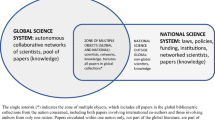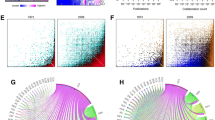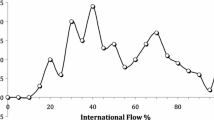Abstract
International collaboration in science continues to grow at a remarkable rate, but little agreement exists about dynamics of growth and organization at the discipline level. Some suggest that disciplines differ in their collaborative tendencies, reflecting their epistemic culture. This study examines collaborative patterns in six previously studied specialties to add new data and analyze patterns over time. Our findings show that a global network of collaboration continues to add new nations and new participants; since 1990, each specialty has added many new nations to lists of collaborating partners. We also find that the scope of international collaboration is positively related to impact. Network characteristics for the six specialties are notable in that instead of reflecting underlying culture, they tend towards convergence at the global level. This observation suggests that the global level may represent next-order dynamics that feed back to the national and local levels (as subsystems) in a complex, networked hierarchy.

Data: Web of Science

Data: Scopus


Similar content being viewed by others
References
Abt, H. A. (2007). The frequencies of multinational papers in various sciences. Scientometrics, 72(1), 105–115.
Adams, J. (2012). Collaborations: The rise of research networks. Nature, 490(7420), 335–336.
Adams, J. (2013). The fourth age of research. Nature, 497, 557–559.
Adams, J. Black, G, Clemmons, R. Stephan, P. Scientific teams and institutional collaborations: Evidence from U.S. universities, 1981–1999 (2005), Research Policy 34, 259-285.
Barabási, A. L., Jeong, H., Neda, Z., Ravasz, E., Schubert, A., & Vicsek, T. (2002). Evolution of the social network of scientific collaborations. Physica A, 311(3–4), 590–614.
Barjak, F., & Robinson, S. (2008). International collaboration, mobility and team diversity in the life sciences: impact on research performance. Social Geography, 3(1), 23–36.
Borgatti, S. P., Everett, M. G., & Freeman, L. C. (2002). UCInet for windows: Software for social network analysis. Harvard: Analytic Technologies.
Bornmann, L., Wagner, C., & Leydesdorff, L. (2015). BRICS countries and scientific excellence: A bibliometric analysis of most frequently cited papers. Journal of the Association for Information Science and Technology, 66(7), 1507–1513.
Choi, S. (2012). Core-periphery, new clusters, or rising stars? international scientific collaboration among ‘advanced’ countries in the era of globalization. Scientometrics, 90(1), 25–41.
Choi, S., Yang, J. S., & Park, H. W. (2015). The triple helix and international collaboration in science. Journal of the Association for Information Science and Technology, 66(1), 201–212.
De Nooy, W., Mrvar, A., & Batagelj, V. (2011). Exploratory social network analysis with Pajek (Vol. 27). Cambridge University Press.
De Solla Price, D. J., & Beaver, D. (1966). Collaboration in an invisible college. American Psychologist, 21(11), 1011.
Doré, J.-C., Ojasoo, T., & Okubo, Y. (1996). Correspondence factorial analysis of the publication patterns of 48 countries over the period 1981–1992. Journal of the American Society for Information Science, 47(8), 588–602.
Folke, C., Hahn, T., Olsson, P., & Norberg, J. (2005). Adaptive governance of social-ecological systems. Annual Review of Environment and Resources, 30, 441–473.
Frenken, K., Hoekman, J., Kok, S., Ponds, R., van Oort, F., & van Vliet, J. (2009). Death of distance in science? A gravity approach to research collaboration. In Innovation networks (pp. 43-57). Springer Berlin Heidelberg.
Gazni, A., Sugimoto, C. R., & Didegah, F. (2012). Mapping world scientific collaboration: Authors, institutions, and countries. Journal of the American Society for Information Science and Technology, 63(2), 323–335.
Gilsing, V., Nooteboom, B., Vanhaverbeke, W., Duysters, G., & van den Oord, A. (2008). Network embeddedness and the exploration of novel technologies: Technological distance, betweenness centrality and density. Research Policy, 37(10), 1717–1731.
Girvan, M., & Newman, M. E. (2002). Community structure in social and biological networks. Proceedings of the National Academy of Sciences, 99(12), 7821–7826.
Glänzel, W., & De Lange, C. (2002). A distributional approach to multinationality measures of international scientific collaboration. Scientometrics, 54, 75–89.
Glänzel, W., & Schubert, A. (2001). Double effort = double impact? A critical view at international co-authorship in chemistry. Scientometrics, 50(2), 199–214.
Glänzel, W., & Schubert, A. (2005). Domesticity and internationality in co-authorship, references and citations. Scientometrics, 65(3), 323–342.
Halevi, G., Moed, H. F., & Bar-Ilan, J. (2016). Researchers’ mobility, productivity and impact: Case of top producing authors in seven disciplines. Publishing Research Quarterly, 32(1), 22–37.
He, T. (2009). International scientific collaboration of China with the G7 countries. Scientometrics, 80(3), 571–582.
Hoekman, J., Frenken, K., & Tijssen, R. J. (2010). Research collaboration at a distance: Changing spatial patterns of scientific collaboration within Europe. Research Policy, 39(5), 662–673.
Jeong, H., Néda, Z., & Barabási, A. L. (2003). Measuring preferential attachment in evolving networks. EPL (Europhysics Letters), 61(4), 567.
Jonkers, K., & Cruz-Castro, L. (2013). Research upon return: The effect of international mobility on scientific ties, production and impact. Research Policy, 42(8), 1366–1377.
Katz, J. (1994). Geographical proximity and scientific collaboration. Scientometrics, 31(1), 31–43.
Kontopoulos, K. M. (1993). The logics of social structure. Cambridge: Cambridge University Press.
Luukkonen, T., Persson, O., & Sivertsen, G. (1992). Understanding patterns of international scientific collaboration. Science, Technology and Human Values, 17(1), 101–126.
Mattsson, P., Laget, P., Nilsson, A., & Sundberg, C. J. (2008). Intra-EU vs. Extra-EU scientific co-publication patterns in EU. Scientometrics, 75(3), 555–574.
Miquel, J. F., & Okubo, Y. (1994). Structure of international collaboration in sciences. Comparisons of profiles in countries using a link indicator, Scientometrics, 29, 271–294.
Monge, P. R., & Contractor, N. S. (2003). Theories of communication networks. USA: Oxford University Press.
Narin, F., Stevens, K., & Whitlow, E. (1991). Scientific co-operation in Europe and the citation of multinationally authored papers. Scientometrics, 21(3), 313–323.
Newman, M. E. (2001a). Clustering and preferential attachment in growing networks. Physical Review E, 64(2), 025102.
Newman, M. E. (2001b). The structure of scientific collaboration networks. Proceedings of the National Academy of Sciences, 98(2), 404–409.
Padgett, J. F., & Powell, W. W. (2012). The emergence of organizations and markets. Princeton: University Press.
Palla, G., Barabási, A. L., & Vicsek, T. (2007). Quantifying social group evolution. Nature, 446(7136), 664–667.
Persson, O., Glänzel, W., & Danell, R. (2004). Inflationary bibliometric values: The role of scientific collaboration and the need for relative indicators in evaluative studies. Scientometrics, 60(3), 421–432.
Ponds, R. (2009). The limits to internationalization of scientific research collaboration. The Journal of Technology Transfer, 34(1), 76–94.
Scott, J. (2000). Social network analysis. London: Sage Publications.
Simon, H. A. (1977). The organization of complex systems. In Models of discovery (pp. 245–261). Netherlands: Springer.
Simon, H. A. (1991). The architecture of complexity. In G. Klir (Ed.), Facets of Systems Science. International Federation for Systems Research International Series on Systems Science and Engineering (Vol. 7, pp. 457–476). US: Springer.
Sonnenwald, D. H. (2007). Scientific collaboration. Annual review of information science and technology, 41(1), 643–681.
Valverde, S., & Solé, R. V. (2007). Self-organization versus hierarchy in open-source social networks. Physical Review E, 76(4), 046118.
Wagner, C. S. (2005). Six case studies of international collaboration in science. Scientometrics, 62(1), 3–26.
Wagner, C. S., & Leydesdorff, L. (2005). Network structure, self-organization, and the growth of international collaboration in science. Research Policy, 34(10), 1608–1618.
Wagner, C. S., Park, H. W., Leydesdorff, L., & Glanzel, W. (2015). The continuing growth of global cooperation networks in research: A conundrum for national governments. PLOS ONE, 10(7), e0131816.
Whitley, R. (1984). The intellectual and social organisation of the sciences. Oxford: Oxford University Press.
Wuchty, S., Jones, B. F., & Uzzi, B. (2007a). The increasing dominance of teams in production of knowledge. Science, 316(5827), 1036–1039.
Wuchty, S., Jones, B. F., & Uzzi, B. (2007b). Supporting online materials for the increasing dominance of teams in production of knowledge. www.sciencemag.org/cgi/content/full/1136099/DC1.
Zeng, S. X., Xie, X. M., & Tam, C. M. (2010). Relationship between cooperation networks and innovation performance of SMEs. Technovation, 30(3), 181–194.
Acknowledgements
We wish to thank Jeroen Bass at Elsevier for assistance in developing the data for the global level and for the specialties for 2008 and 2013. We thank Meng Li for assistance with statistical analysis.
Author information
Authors and Affiliations
Corresponding author
Appendix 1 List of Journals found to be most central to the specialty, examined for four different years, 1990, 2000, 2008, 2013
Appendix 1 List of Journals found to be most central to the specialty, examined for four different years, 1990, 2000, 2008, 2013
Astrophysics Journals
Annual Review of Astronomy and Astrophysics
Astrophysical Letters and Communications
Astronomy and Astrophysics Supplement Series
Astronomy and Astrophysics
Astronomical Journal
Astronomy Letters-A Journal of Astronomy and Space
Astrophysics
Astronomy Reports
Astrophysical Journal
Astrophysical Journal Supplement Series
Astrophysics and Space Science
Publications of The Astronomical Society of Japan
Monthly Notices of the Royal Astronomical Society
Publications of The Astronomical Society of the Pacific
Solar Physics
Mathematical Logic
Mathematical Logic Quarterly
History and Philosophy of Logic
Bulletin of Symbolic Logic
Archive for Mathematical Logic
Annals of Pure and Applied Logic
Polymer Science
Progress in Polymer Science
Polymer Bulletin
Macromolecular Symposia
Macromolecules
Macromolecular Chemistry and Physics
Journal of Polymer Science Part A-Polymer Chemistry
Journal of Polymer Science Part B-Polymer Physics
Journal of Macromolecular Science-Pure and Applied Chemistry
European Polymer Journal
Biopolymers/Pva Hydrogels/Anionic Polymerisation Nanocomposites
Seismology
Soil Dynamics and Earthquake Engineering
Bulletin of The Seismological Society of America
Journal of Seismology
Physics of The Earth and Planetary interiors
Earth Planets and Space
Geophysical Journal international
Geophysical Research Letters
Journal of Geophysical Research-Solid Earth
Tectonophysics
Soil Science
Advances in Agronomy
Australian Journal of Soil Research
Canadian Journal of Soil Science
Communications in Soil Science and Plant Analysis
European Journal of Soil Science
Forest Ecology and Management
Geoderma
Soil Science Society of America Journal
Soil Science
Soil and Tillage Research
Virology
Advances in Virus Research
Virology
Advances in Virus Research
Archives of Virology
Journal of General Virology
Journal of Medical Virology
Journal of Virology
Journal of Virological Methods
Virus Genes
Virus Research
Journal of Virology
Rights and permissions
About this article
Cite this article
Wagner, C.S., Whetsell, T.A. & Leydesdorff, L. Growth of international collaboration in science: revisiting six specialties. Scientometrics 110, 1633–1652 (2017). https://doi.org/10.1007/s11192-016-2230-9
Received:
Published:
Issue Date:
DOI: https://doi.org/10.1007/s11192-016-2230-9




